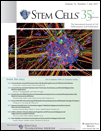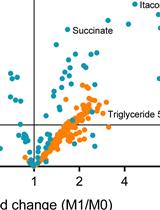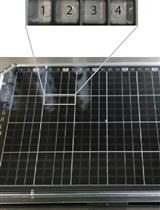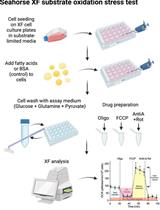- EN - English
- CN - 中文
Ex vivo Analysis of Lipolysis in Human Subcutaneous Adipose Tissue Explants
人体皮下脂肪组织外植体脂解作用的离体分析
发布: 2018年02月05日第8卷第3期 DOI: 10.21769/BioProtoc.2711 浏览次数: 7980
评审: Salma MerchantAnonymous reviewer(s)
Abstract
Most studies of human adipose tissue (AT) metabolism and functionality have been performed in vitro on isolated mature adipocyte or in situ using the microdialysis technique (Lafontan, 2012). However, these approaches have several limitations. The use of mature isolated adipocytes is limiting as adipocytes are not in their physiological environment and the collagenase digestion process could affect both adipocyte survival and functionality. While metabolic studies using microdialysis have brought the advantage of studying the lipolytic response of the adipose tissue in situ, it provides only qualitative measures but does not give any information on the contribution of different adipose tissue cell components. Moreover, the number of microdialysis probes that can be used concomitantly in one subject is limited and can be influenced by local blood flow changes and by the molecular size cut-off of the microdialysis probe. Here we present a protocol to assess adipose tissue functionality ex vivo in AT explants allowing the studies of adipose tissue in its whole context, for several hours. In addition, the isolation of the different cell components to evaluate the cell-specific impact of lipolysis can be performed. We recently used the present protocol and demonstrated that fatty acid release during lipolysis impacts directly on a specific cell subset present in the adipose tissue stroma-vascular compartment. This assay can be adapted to address other research questions such as the effects of hormones or drugs treatment on the phenotype of the various cell types present in adipose tissue (Gao et al., 2016).
Keywords: Human adipocyte biology (人类脂肪细胞生物学)Background
Human white adipose tissue (WAT) plays a major role in body energy homeostasis. Adipocytes, specialized cells expressing specific lipid handling metabolic activities, constitute more than 90% of the volume of WAT (Lafontan, 2012). In addition to adipocytes, other cell types are present within human WAT e.g., vascular cells, immune cells (lymphocytes and macrophages) and progenitor cells involved in WAT remodeling and renewal. The metabolic activity of adipocytes is tightly controlled by the integration of both local and systemic pathways. Neurohumoral signals modulated in anabolic or catabolic conditions impact on the net adipocyte metabolic activity, i.e., energy storage or release. In post-prandial conditions, non-esterified fatty acids (NEFAs) originating from the hydrolysis of VLDL and chylomicron particles are taken up by the adipocytes and esterified to glycerol phosphate to form triglycerides packaged into a single lipid vacuole (Large et al., 2004). This process called lipogenesis, is mainly under the control of insulin. In conditions of energy demand such as exercise or fasting, hydrolysis of triacylglycerol through a process called lipolysis results in the release of glycerol and NEFAs into the circulation thereby providing energy to other tissues and organs. Lipolysis involves the sequential hydrolysis of triacylglycerol through the successive action of lipolytic enzymes, i.e., adipose triglyceride lipase, hormone sensitive lipase and monoacylglycerol lipase. In human adipocytes, lipolysis is mainly stimulated by catecholamines and atrial natriuretic peptide (ANP). Catecholamines mediate their pro-lipolytic effects through β-adrenoceptors (β1-AR and β2-AR), while alpha2-adrenoceptors are anti-lipolytic; ANP acts via NPR-A to activate lipolysis (Lafontan, 2012). It should be noted that in human AT the beta3-adrenergic receptor is almost not expressed and is not functional. The classical approach to evaluate adipocyte lipolytic responses was developed by Robdell (Robdell, 1964) who first described mature adipocyte isolation based on flotation after collagenase digestion. Although this technique is used worldwide, it presents several limitations. Firstly, the buoyancy of isolated mature adipocytes will prevent, with increasing time in vitro, their immersion into media and promote direct toxic effects through air contact, ultimately leading to cell damage and disintegration. Secondly, the isolation process per se alters adipocyte phenotype (Ruan et al., 2003). Thirdly, the isolated mature adipocytes are disconnected from their natural microenvironment including extracellular matrix and from other cell types (vascular cells, immune cells (lymphocytes and macrophages) and progenitor cells). Moreover, cytokines such as TNF-alpha and IL6, present in the AT microenvironment, are well described to impact adipocyte lipolysis. Finally, NEFAs originating from in situ lipolysis may have different fates: 1) release into the circulation, 2) re-esterification within the mature adipocytes, 3) potentially taken up by other cell types in the near vicinity of mature adipocytes including progenitor cells. Thus studies on isolated adipocytes do not take into account these different factors.
The present technique allows the study of the lipolytic responsiveness of mature adipocytes for a longer time in their natural context 1) in a closed culture chamber avoiding direct contact with air but with adequate and modulable gas exchange, 2) without the necessity of a collagenase digestion step and 3) in a maintained viable microenvironment. This approach was recently published by our groups and clearly demonstrate that lipolytic stimulation is associated with increased fatty acid uptake by the progenitor cells leading to enhanced adipogenic capacity (Gao et al., 2016).
Materials and Reagents
- Pipettes tips (Dutscher, ClearLine®, catalog numbers: 037660CL (10 µl); 032260CL (200 µl); 027120CL (1,000 µl))
- 50 ml conical tubes (Corning, Falcon®, catalog number: 352070 )
- 20 ml syringe (Terumo, catalog number: SS-20ES1 )
- Sterile individually packaged 5 ml graduated pipettes (Corning, Falcon®, catalog number: 357543 )
- Sterile 150 x 20 mm cell culture polystyrene Petri dish (Thermo Fisher Scientific, Thermo ScienticTM, catalog number: 168381 )
- 10 ml syringe (Terumo, catalog number: SS-10ES1 )
- Sterile individually needle 21 G x 11/2” (Terumo, catalog number: NN-2138R )
- 15 ml conical tubes (Greiner Bio One International, catalog number: 188271 )
- 0.22 µm syringe filter (Dutscher, catalog number: 051732 )
- 96 wells microplate clear flat bottom (Thermo Fisher Scientific, Thermo ScienticTM, catalog number: 269620 )
- 50 ml syringe (Terumo, catalog number: SS-50L1 )
- Filtration unit for sterilization, Stericup 500 ml (Merck, catalog number: SCGPU05RE )
- Clinicell® 25 cassette (Mabio International, catalog number: 00109 )
- RNA lysis buffer (Quiazol, QIAGEN, catalog number: 79306 )
- Free glycerol reagent (Sigma-Aldrich, catalog number: F6428 )
- Wako NEFA (SOBIODA, catalog numbers: W1W434-91795 and W1W436-91995 )
- Lactate FS (Diasys Diagnostics, catalog number: 1400199109 )
- Phosphate-buffered saline (PBS) (Sigma-Aldrich, catalog number: D8537 )
- Glucose GOD FS (Diasys Diagnostics, catalog number: 1250099100 )
- Gentamycin (Sigma-Aldrich, catalog number: G1272 )
- ECBM buffer (PromoCell, catalog number: C-22210 )
- Bovine serum albumin (BSA) (Sigma-Aldrich, catalog number: A7030 )
- HEPES 1 M (PAA, catalog number: S11-001 )
- Sodium bicarbonate (Sigma-Aldrich, catalog number: S5761 )
- Krebs Ringer powder (Sigma-Aldrich, catalog number: K4002 )
- (-)Isoproterenol hydrochloride (Sigma-Aldrich, catalog number: I6504 )
- Human alpha-ANF(1-28) (R&D Systems, catalog number: 1906/1 )
- ECBM medium (see Recipes)
- BSA free fatty acid 20% (see Recipes)
- Adipose tissue explant media (ATEM) (see Recipes)
- Krebs-Ringer Bicarbonate HEPES 0.1% BSA (KRBHA) (see Recipes)
- Isoproterenol stock solution (see Recipes)
- ANP stock solution at 200 µM (see Recipes)
Equipment
- P20 pipetman (Gilson, catalog number: F123600 )
- P200 pipetman (Gilson, catalog number: F123601 )
- P1000 pipetman (Gilson, catalog number: F123602 )
- Laminar flow hood (Faster, model: BHA36 )
- Sterile steel stainless scissors, 16 cm, straight (Dutscher, catalog number: 005055 )
- Sterile stainless steel dressing forceps 11.5 cm, straight (Dutscher, catalog number: 711202 )
- Stainless steel round-point needle 14 G x 6” (Dutscher, catalog number: 075515 )
- Refrigerated tabletop centrifuge for 15 and 50 ml conical tube (Eppendorf, model: 5810 R )
- 37 °C, 5% CO2 water jacketed incubator (Thermo Fisher Scientific, Thermo ScienticTM, model: HeraCellTM 150i )
- Pipettor PipetGirl (Integra Biosciences, catalog number: 155 021 )
- Benchtop dry bath (Thermo Electron LED, catalog number: D-63505 )
- Autoclave
- -20 °C freezer
- 100 ml beaker (Corning, PYREX®, catalog: 1000-100 )
- 1 L beaker (Corning, PYREX®, catalog: 1000-1L )
- Microplate spectrophotometer (Labsystem, model: iEMS Reader MF )
- pH-meter (Mettler-Toledo, model: EL20 )
Software
- Excel 2013
- GraphPad Prism6 software
Procedure
文章信息
版权信息
© 2018 The Authors; exclusive licensee Bio-protocol LLC.
如何引用
Decaunes, P., Bouloumié, A., Ryden, M. and Galitzky, J. (2018). Ex vivo Analysis of Lipolysis in Human Subcutaneous Adipose Tissue Explants. Bio-protocol 8(3): e2711. DOI: 10.21769/BioProtoc.2711.
分类
细胞生物学 > 细胞新陈代谢 > 脂质
您对这篇实验方法有问题吗?
在此处发布您的问题,我们将邀请本文作者来回答。同时,我们会将您的问题发布到Bio-protocol Exchange,以便寻求社区成员的帮助。
Share
Bluesky
X
Copy link












